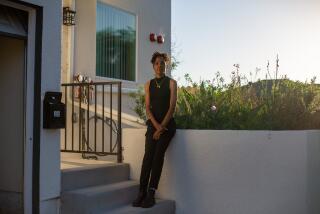Live-In University Program Blends Advantages of Big, Small Schools
ANN ARBOR, Mich. — Michael Corrigan heard the horror stories in high school: Attend a large university and you’ll be just a number.
Still, Corrigan had his heart set on the University of Michigan, with a main campus enrollment of about 35,000. “I wasn’t scared about the size of the university so much as I didn’t want to not be able to see my teacher when I wanted to if I was having a problem or trouble with my work.”
Then he found out he could have it both ways.
Living-Learning Community
Corrigan signed up for The Pilot Program, a “living-learning community” that offers a personal approach to education through small classes taught by instructors who are resident advisers in the dormitory where the students live.
The 26-year-old program, emulated at other schools, draws freshmen and sophomores from all majors and cultural backgrounds. Because of its size--400 students--they also must take some courses with the rest of the population.
“People who studied education in the ‘60s thought a lot about the potential for combining academic life with the rest of life,” said director Richard Meisler, known in the academic community for his book, “Trying Freedom: A Case for Liberating Education.”
Pilot co-founder Donald R. Brown, now director of Michigan’s Center for Research on Learning and Teaching, said the living-learning concept originated with monasteries, and at the college level with Oxford-Cambridge. And while many small schools operated with that theory in mind, the University of Michigan had no large public university to turn to for a model.
“None of the specific details were simply lifted, they were really invented,” he said, adding that the school’s Residential College, founded in 1967, evolved simultaneously. That program, which also survives, is a four-year program that operates as a full college with its own faculty.
Positive Factor
Out-of-classroom contact between students and instructors can be a positive factor in student performance, said Russell Edgerton, president of the American Assn. for Higher Education.
Students would benefit more if tenured professors could participate, Edgerton said, “But the costs are just astronomical. That’s why students pay a lot more to attend small, liberal arts colleges.”
Administrators say the cost of educating a Pilot student is comparable to that for other students, because the cost of individualized attention is made up for by the lower cost of graduate assistants and more efficient use of space. No extra fees are charged for participation in the program.
Edgerton said a current trend in education is “federated learning communities,” in which a group of students takes three classes with a common theme, such as poverty or hunger. The three professors would work together on developing course material and would team teach.
At Indiana University’s Collins Living-Learning Center, courses usually are designed by a professor and only one faculty member lives with the students, said Director Ernest Bernhardt-Kabisch.
Needed Supervision
John Fowler, director of the Sewall Residential Academic Program at the University of Colorado, said the 18-year-old program experimented with resident graduate instructors but decided more resident advisers were needed. The change was made not for academics, but because students needed more supervision.
Like the Ann Arbor program, retention rates are much higher than in the whole university, and there are fewer students on academic probation, he said.
“It’s not easier. Get that out of your mind right now,” said Falesa Ivory, 21, a senior psychology major from Chicago who says her Pilot grades were comparable to her other marks.
The Pilot Program has not compiled detailed statistics on student performance compared to the university at large. However, co-founder Brown said the school’s housing department kept track of each unit’s performance in areas such as academics, intramural sports and vandalism during the 1960s.
The unit the first Pilot students moved into had one of the lowest grade-point averages and one of the highest vandalism rates. After a few years, Pilot students were among the highest in academics and lowest in vandalism.
Increased Retention Rate
A 1981-84 study conducted showed that while minority students at Michigan had higher dropout rates than other students, those in the Pilot Program had an 80% to 95% retention rate. The university at large had a 70% retention rate, said David Schoem, a former director.
In the Pilot Program, many of the courses may be used toward general education requirements. Students may find them more interesting because they deal with specific themes.
Raouf Mama, resident director for academics, teaches an English composition course focusing on human relationships as they appear in literature.
Jim Hartman, who is pursuing a master’s degree in environmental education, teaches a course called Planet Management, focusing on issues like world hunger and politics. Their final exam might be to develop a dorm program or display on a specific crisis. One group of students discussing homelessness decided the best way to learn about it was to hit the streets.
Hartman, also the hall’s resident director for activities, said: “For me, the thing about learning is if you can participate and be creative, have some power in your learning, then you have a better chance of learning.”
More to Read
Sign up for Essential California
The most important California stories and recommendations in your inbox every morning.
You may occasionally receive promotional content from the Los Angeles Times.









